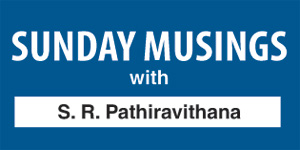Fast and furious: Future of Lanka’s cricket
View(s):Recently I watched a clip made during the heydays of the great West Indian fast bowling machine that took Caribbean cricket to astronomical heights. After the legendary bodyline series which was used only as a ploy to curb the Bradman dominance over the Englishmen, this was the time when a cricketing nation used fast bowling as a ramrod to counter any batsman’s dominance at the crease.
 Unlike the Dennis Lillee-Jeff Thomson combination of Australia, the Frank Tyson-Brian Statham pair of England, the Wasim Akram-Waqar Younis combination of Pakistan or the former West Indian fast bowling duo of Wesley Hall and Charlie Griffith, Clive Lloyd’s fast bowling machine brought in relentless ferocity.
Unlike the Dennis Lillee-Jeff Thomson combination of Australia, the Frank Tyson-Brian Statham pair of England, the Wasim Akram-Waqar Younis combination of Pakistan or the former West Indian fast bowling duo of Wesley Hall and Charlie Griffith, Clive Lloyd’s fast bowling machine brought in relentless ferocity.
The string of fast bowlers who came as a menacing force comprised legends beginning from Andy Roberts, Malcolm Marshall, Michael Holding, Joel Garner, Colin Croft, first in dominance. At that time Ian Bishop, Courtney Walsh, Curtly Ambrose, and Patrick Patterson were all still at school. They took the West Indian rule over the cricketing world from 1976 to 1990 — a string of fast bowlers that came in two generations.
Yet, once the West Indian pace influence caved in, it never was the same, but, the fad never went out of fashion. However, the off spin-leg spin duo of Muttiah Muralitharan and Shane Warne came in at the tail end of the twentieth century and the first few moons of the twenty first century. They shared an astronomical tally of 2,335 wickets in both forms of the game. With their spin dominance, the accent of the game changed somewhat.
May be because of this dominance of the slower bowlers and countries like Sri Lanka and India gradually coming to dominate the game with the slower stuff, the World Cricket authority gradually worked back the status with guile, especially in the limited overs form, where they came up with field restrictions and two new balls at either end.

Sri Lanka Cricket hired the services of Michael Main to condition the Lankan cricketers for the near future
That really made a difference in the 2015 World Cup played in Australia and New Zealand. Once again fast bowling became the yard-stick. The three countries which had the best fast bowling attacks — Australia, New Zealand and South Africa, were a cut above the rest and became firm favourites even before the first ball was delivered. However, unknowingly India too had worked out their own army of fast bowlers and came to the battle with at least three fast bowlers who could bowl in the range of 138+.
These four teams came on top. England and the West Indies, even though they had the ability to produce bowlers of 140+, did not have the same ferocity that the bowlers of the other nations could chalk up, and along with Sri Lanka who had been in the World Cup limelight since 1996 (barring the 1999 World Cup where they bowed out in the first round) were left behind.
Now it is time for Sri Lanka to pick-up the pieces and think of tomorrow. It was proved what the Lankans could offer – the 130 to 135 range is not adequate. The spinners cannot contain the run flow in the last fifteen overs as a result of the field restrictions. This means the Nuwan Kulasekeras and the Suranga Lakmals will not be effective enough to bring home wins unless the matches are played at home. A catch-22 situation, but the Lankans have to gear themselves for the future.
Playing abroad, there will be many more Maxwells and McCullums to flay those medium pace stuff. In general all top batsmen, including ours, are geared to tear apart the medium pace stuff now. So it is imperative we change for the better. When the Argus report reached us five years ago, our system was reluctant to take up the challenge because we were quite comfortable with the status quo. But, the Australians who had faced a setback by then — and thus the report — worked on it and gradually shaped their cricket.
More than the upper body and the limbs, they began to work on the core that gives you the strength and power from the middle of the body and now the new generation of Mitchell Starks and Mitchell Johnsons are doing that. Now more than ninety per cent of the ODI wickets are flat batting tracks. So if there are bowlers who could generate 140+ and be accurate and get the batsmen playing on the back foot, they may be able to contain, if not, you are bound to go for tons of runs.
Luckily we learn that the Lankans have now shifted their accent and are trying to produce bowlers with that extra zip. May be they should get the Indian secret and learn how they produced Umesh Yadav, Mohammed Shami and Mohit Sharma who shut the doors for three other bowlers who were considered good just prior to the World Cup tournament.
Even the Lankans are mindful about the physical limitations, but, it is the need of the hour and the future game depends upon it. The Lankan coaching system is confident that they could work on the ‘core’ factor and get our young generation to get the extra yard. It is good to hear that Binura Fernando and Dushmantha Chameera who are on the upper limits of the speed gun are willing workers and striving to be better than what they are.
Now the question is how to sustain speed and accuracy. To be hot in world cricket, you have to be good in both at the same time. That is why the first round game between New Zealand and Australia in the World Cup was the best game in the entire tournament. In a tournament dominated by batsmen, there was one game that pacies of both sides came up and produced memorable exhibition of sustained fast bowling.
In their mission to the future the Lankans have obtained the services of Michael Main who has joined Sri Lanka Cricket as trainer of the National Team.
Michael Main was the Head of Strength and Conditioning at Hampshire county cricket team under ECB before joining SLC. Main holds a Master’s Degree in Strength and Conditioning from the University of Teeside, England and a bachelor’s degree from University of Worcester in Sports Studies and Physical Education. He had also worked with ECB in their young fast bowlers training programme.
Good, a product of the new generation. The system feels that he had the wherewithal to take the Lankan fast bowling to the next step.
Our argument is Lanka’s vulnerability does not lie in their batting. With a little exposure batting could settle in. But, the challenge is especially fast bowling if you desire to live with the Joneses next door.


